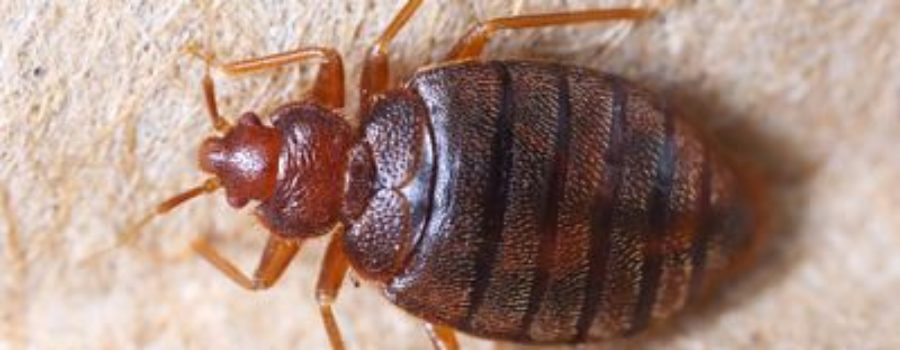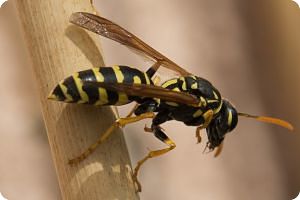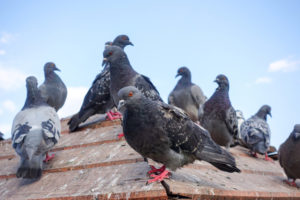What are bed bugs and what do they look like?
Bed bugs (Cimex lectularius) are small, oval, flattened, brownish insects that feed on the blood of animals or humans. Adult bed bugs are about 3/16” long or about the size of an apple seed. They usually feed at night, and after feeding their bodies swell and turn a reddish color.
What is a bed bugs life cycle?
Adult female bed bugs lay their eggs in secluded places, depositing 1, 2, or more eggs per day. The eggs are sticky (so they can adhere to surfaces), tiny (about the size of a spec of dust), whitish, and very hard to see without magnification. At room temperature, bed bugs will hatch in about a week. Newly hatched bed bugs are straw colored and about the size of a pinhead. Baby bed bugs, called Nymphs, have five life stages. At the end of each life stage, they shed their skins. A blood meal is needed between each successive shedding of skin. Under favorable conditions (70-80°F), the bed bugs can reach maturity in as little as a month. Under these conditions several generations can be produced per year. Adult females must also feed in order to lay her eggs. Bed bugs are resilient, and may survive in cooler temperatures up to a year without feeding which is unusual for most insects.
When and how do bed bugs feed?
Bed bugs are mainly active at night. They live in groups and typically will hide in mattresses, box springs, bed frames, and headboards during the day. This gives them easy access to people so they can feed at night while people are sleeping. To feed, the bed bug will pierce the skin and withdraw blood through an elongated beak. The bugs will feed from 3 to 10 minutes. Bed bugs do not stay attached to a person like a tick. Instead, after feeding, they become engorged and crawl away to digest their meal. Reactions to bedbug bites vary. Most bed bug bites are painless at first but later the bite site will become itchy and produce welts. Some people will get a reaction within a day, others won’t get a reaction for several days to weeks, and some people won’t get a reaction at all. This can make it difficult to know when and where the bite occurred.
How does infestation of bed bugs occur?
Bed bug infestation is generally not caused by lack of hygiene. These little insects usually are brought into dwellings on a person’s clothing or luggage, backpacks, furniture, pets, and wild animals such as bats or birds. The likelihood of bed bugs increases if the affected individual has been traveling, or if they have acquired used beds or furnishings before symptoms started to appear. Bed bugs are great hitchhikers. They will crawl into a persons’ luggage or backpack at a hotel. Or if a person is visiting a dwelling that has bed bugs, the bed bugs can crawl into purses, on clothing, or even wheelchairs. Once bed bugs are introduced they can crawl from room to room or floor to floor. Unlike fleas and cockroaches, bed bugs don’t need a dirty or messy place to live – they feed on blood. So a place can be extremely clean and pristine, and still have bed bugs.
What are the signs of bed bug infestation?
Waking up with itchy welts you didn’t have when you went to sleep is definitely a sign. It’s important to recognize, however, that not all bite-like reactions are due to bed bugs. Sometimes they are due to mosquitoes, fleas, or carpet beetles. Sometimes the reaction can even look like a rash or hives. And sometimes there is no reaction at all.
-
-
- A more accurate way of identifying a bed bug infestation is to look for physical signs of bed bugs. These include:
- Rusty or reddish stains on linens or mattresses caused by crushed bed bugs.
- Small dark spots on fabric caused by bed bug fecal matter.
- Tiny straw colored eggs
- Straw colored eggshells that are left behind from shedding Nymphs.
- Live bed bugs.
-
Confirmation of bed bug infestation often requires the help of a professional, especially in the early stages. A low-level infestation is more challenging to find and correctly identify. If you misidentify a bug infestation, it gives the bugs more time to spread to other areas of the house or hitchhike a ride to someone else’s house. It is far easier and less costly to treat a minor bed bug infestation than to treat the same infestation after it becomes more widespread.
Where do bed bugs hide?
Bed bugs generally start out hiding on and around the mattress, box springs, headboard, footboard, and bed linens where they can readily feed on a human. Bed bugs tend to live within 8 feet of where humans sleep, however they also have been known to travel over 100 feet in a night. If a room is heavily infested, they can hide in any crack or crevice the width of a credit card.
Places bed bugs hide:
-
-
- On and around your bed – mattress, box springs, headboard, footboard, bed linens.
- In drawer joints.
- In electrical outlets and appliances.
- Under loose wall paper, wall hangings, and pictures.
- At the junction where the wall and ceiling meet.
- Behind baseboards.
- In furniture crevices and upholstery.
- Inside backpacks and suitcases.
- Inside boxes and shoes.
- In cars, buses, and trains.
- Any small crack or crevice near a human.
-
How to prevent bed bugs from infesting your home.
When traveling and staying at a hotel, keep your luggage away from the bed, furniture, and walls. Use your luggage rack to hold your suitcase and backpack. Keep your luggage closed and zipped up. Consider keeping luggage and bags in the bathroom with the light on (bed bugs will most likely be hiding in dark places within the bedroom closer to a potential host). Think about bringing a large plastic trash bag to keep your suitcase in. Consider using a natural insecticide like neem oil by gently misting the bed and its surroundings with the neem oil spray. Bed bugs will mistakenly ingest it and die. Neem oil is a safe and environmentally friendly way to keep bed bugs at bay.
When leaving a hotel room, visually check your luggage, purse, etc for bed bugs. Inspect the seams and crevices as well as your clothes inside.
After traveling on a plane, do the same inspection of your luggage as when leaving a hotel room. It is possible bed bugs have relocated from person’s baggage on the plane and are now resting comfortably on yours.
When arriving home think about vacuuming your suitcases in the garage or outside. For additional assurance place your clothes, clean and dirty, in the dryer on a high setting (at least 120° Fahrenheit) for at least 15 minutes. This should successfully kill any bed bugs and their eggs.
Never bring second-hand furniture, especially mattresses and box springs, into a home without thoroughly examining for signs of a bed bug infestation. You might consider having a pest control professional inspect the furniture as it is difficult to detect an infestation if you are untrained.
The best way to prevent a bed bug infestation is to do regular inspections for signs of bed bugs.
Do bed bugs spread disease?
Bed bugs are not known to spread disease. However, they can be an annoyance because their bites may cause itching and local allergic reactions. Sometimes if a person scratches the bite it can cause a secondary skin infection.
What to do when there is a bedbug infestation?
Bed bug bites usually do not pose a serious medical threat. The best way to treat a bite is to avoid scratching the area and apply antiseptic creams or lotions and take an antihistamine.
Bed bug infestations are commonly treated by insecticide spraying. If you suspect that you have an infestation, contact a professional pest control company.





Leave a Reply
Your email is safe with us.